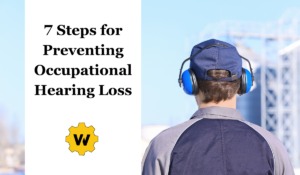Occupational hearing loss is a significant health concern which affects millions of workers worldwide.
Prolonged exposure to loud noise in the workplace can lead to irreversible damage to the auditory system.
In this article, we’ll discuss seven essential steps to protect your workers’ hearing and promote a safer working environment at your worksite.
But, before we delve into it, let’s get you acquainted with some important industry stats on occupational hearing loss…
Related Article: 6 Major Benefits of Workplace Hearing Tests
Related Article: Hearing Loss: The Most Common Occupational Illness in Manufacturing

Here are 6 Major Facts about Occupational Hearing Loss
1. According to the National Institute for Occupational Safety and Health [NIOSH], approx. 22 million U.S. workers are exposed to hazardous occupational noise each year. Additionally, over 30 million workers in the U.S work with or near ototoxic chemicals, which can damage hearing.
2. According to the Center for Disease Control and Prevention [CDC], almost a quarter of hearing issues experienced by U.S. workers can be attributed to occupational exposures. These exposures include hazardous levels of noise and contact with ototoxic chemicals.
3. The S. Bureau of Labor Statistics reports that more than 20,000 workplace hearing loss cases occur yearly. Many of these cases result in permanent hearing loss. Because of this, providing workers with adequate hearing protection is of the utmost importance.
4. Another CDC statistic reveals that 34% of workersexposed to hazardous noise are not provided hearing protection. In order to reduce the number of occupational hearing loss cases, it’s critical that employers provided noise-induced workers with appropriate hearing protection.
5. Here’s some good news… Not all these stats are negative.In fact, the CDC reported that the adjusted risk of occupational hearing loss across all industries has decreased 46% over25 years. This can be attributed to the development of more effective hearing protection and increased awareness of hearing hazards in the workplace.
6. Mining (17%), construction (16%), and manufacturing (14%) have the highest prevalence of workers with hearing loss. These workers are exposed to high levels of noise from loud machinery daily. Consequently, it is important you provide them with hearing protection and become more aware of how long they are spending around loud equipment.
Preventing Occupational Hearing Loss at Your Worksite
Fortunately, there are steps individuals and organizations can take to prevent or minimize the risk of occupational hearing loss.
Let’s break it down…
1. Assess the Workplace Noise Levels
The first step in preventing occupational hearing loss is to assess the noise levels in your workplace. Conduct a thorough evaluation using sound level meters to determine the decibel levels of different areas and tasks. Identify the sources of excessive noise and the duration of exposure. This assessment will provide a baseline for implementing appropriate preventive measures.
See NIOSH’s Industrial Noise Control Manual.
See NIOSH’s Health Hazard Evaluations: Noise and Hearing Loss, 1986-1997.
2. Implement Engineering Controls
Engineering controls aim to reduce or eliminate noise at its source. These measures involve modifying or replacing equipment, machinery, or processes to make them quieter. Examples include using noise-cancelling technologies, sound barriers, and vibration isolation systems. By implementing engineering controls, you can reduce the overall noise levels in the workplace, thereby lowering the risk of hearing damage.
See OSHA’s guidelines on Occupational Noise Exposure; exposure and controls.
3. Encourage the Use of Personal Protective Equipment (PPE)
When it’s not feasible to eliminate or control noise levels through engineering measures alone, personal protective equipment (PPE) becomes crucial. Provide your workers with appropriate hearing protection, such as earplugs or earmuffs, and ensure that they are trained in their correct usage.
Regularly inspect and maintain the PPE to ensure its effectiveness. Emphasize the importance of wearing hearing protection consistently, especially in high-noise areas.
4. Establish Hearing Conservation Programs
Hearing conservation programs are comprehensive strategies designed to prevent and monitor occupational hearing loss. These programs should include regular noise monitoring, audiometric testing, employee education and training, and ongoing evaluation of control measures. Such programs enable early detection of hearing loss, prompt intervention, and ensure compliance with relevant regulations.
5. Educate and Train Employees
Raising awareness about the risks of occupational hearing loss is crucial for prevention. Educate employees about the potential hazards of excessive noise, the signs of hearing loss, and the importance of utilizing protective measures. Provide training on proper PPE usage, maintenance, and the importance of regular hearing check-ups.
Promote a culture of responsibility, where every employee takes an active role in protecting their hearing health.
6. Implement Work Rotation and Rest Periods
Extended exposure to high noise levels can significantly increase the risk of hearing damage. Implementing work rotation schedules and rest periods can help minimize the duration of exposure and provide the auditory system with essential recovery time.
By allowing employees to alternate between noisy and quiet tasks and ensuring adequate breaks, you reduce the cumulative effects of noise exposure and lower the risk of hearing loss.
7. Regularly Monitor and Review Control Measures
Preventing occupational hearing loss is an ongoing effort that requires consistent monitoring and evaluation of control measures. Regularly review noise exposure levels, the effectiveness of engineering controls and PPE usage, and the overall success of the hearing conservation program.
This ongoing assessment will help identify areas for improvement and ensure that preventive measures remain up-to-date and effective.
Key takeaways
Occupational hearing loss is a preventable condition that demands proactive measures from both individuals and organizations.
By following these seven steps—assessing noise levels, implementing engineering controls, promoting the use of PPE, establishing hearing conservation programs, educating employees, implementing work rotation and rest periods, and regularly monitoring control measures—you can significantly reduce the risk of hearing loss in the workplace.
Remember, prioritizing hearing protection not only safeguards the well-being of employees but also contributes to a safer and more productive work environment.
Mobile Audiometric Testing
For audiometric testing, which is required by OSHA, Worksite Medical brings the examinations directly to your worksite. Employers must make audiometric testing available at no cost to all employees who are exposed to an action level of 85 dB or above, measured as an 8-hour TWA.
You can get up to six audio booths and up to 20 exams per hour for efficient testing. Audiometric testing is pure tone air-conducted hearing testing performed in each ear at frequencies of 500, 1K, 2K, 3K, 4K, 6K, and 8K. This sort of testing identifies hearing levels and sensitivity to the exposed sound.
We also provide hearing safety training. And, you never have to send your team members away to a clinic. Get your risk-free quote or schedule your on-site audiometric exams below. Let’s keep your team safe and stay ahead of OSHA inspections together.
Take a virtual tour of our mobile medical units HERE.
***
About Worksite Medical
In most cases, OSHA requires medical surveillance testing, and at no cost to employees.
Worksite Medical makes that program easier with mobile medical testing.
We conduct on-site respirator fit tests, as well as audiometric exams, pulmonary function tests and heavy metal lab work, right on your job site. We also keep accurate, easy-to-access medical records for your convenience. You’ll keep your employees at work, and stay ahead of OSHA inspections.




